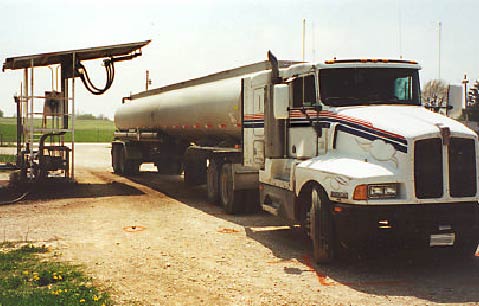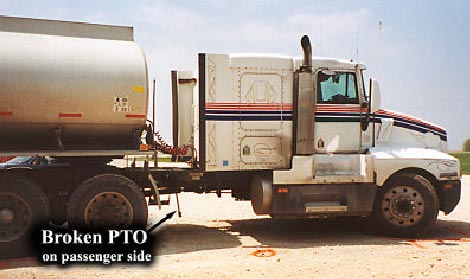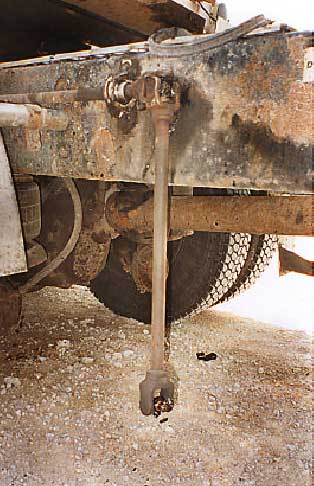

Tanker Truck Driver Killed by Unshielded PTO Shaft
SUMMARY
In May 2002, a 61-year-old truck driver working for a farm supply cooperative was killed when he became entangled in an auxiliary power take-off (PTO) shaft of a truck tractor. This PTO shaft transferred power from the tractor engine to fuel pumps on the tanker trailer. The PTO shaft was mounted on the outside of the tractor frame on the passenger side. The victim was working alone in the morning unloading a tanker trailer load of diesel fuel he had picked up the night before. After successfully unloading the fuel into a bulk tank nearby, he entered the area near the PTO shaft, between the cab and the rear wheels of the tractor. The unguarded, rotating PTO shaft caught his loose-fitting jacket, and he was instantly entangled, and died at the scene from a broken neck. A coworker arrived at approximately 9:00 a.m. to the work site, saw the truck running, and noticed the victim caught in the PTO shaft, which had broken during the entanglement. The shield for the PTO was missing, and employees and supervisors were unable to locate it, and had no information why, or when, the shield had been removed.
RECOMMENDATIONS based on our investigation are as follows:

Photo 1 — View of tanker truck at fuel dump station at the cooperative. 1
INTRODUCTION
In May 2002, a 61-year-old male truck driver was killed when he was entangled in an auxiliary PTO shaft on a tanker truck. The Iowa FACE Program was notified of this fatality two days later from a local newspaper article, and began an investigation. Information was gathered from the County Sheriff, the medical examiner, company managers, and a safety company that provided training for the employer. Photographs of the scene were obtained, and after telephone interviews, it was determined a site visit was not necessary.

Photo 2 — Passenger side of truck showing broken PTO shaft. 1
The employer was a farm supply company offering services in grain handling, feeds, fertilizers, chemicals, and other farm supplies. They had been in business for 90 years, and had 47 full-time employees at this local office, five of which were truck drivers. Some drivers at this company also had other work duties, but the victim was only responsible for driving a truck. He had worked at this cooperative as a truck driver for the past 12 years.
This cooperative is a year-round business offering multiple services to agricultural operations in the region. The company safety program was administered by an outside company, which had recently been contracted to handle employee training. The areas covered were general OSHA standards for industry, i.e. right-to-know, lock-out/tag-out, confined space entry, machine guarding, slips and falls, and other safety issues. Also covered were specific agricultural supply precautions for anhydrous ammonia, propane transfer, and handling of agricultural chemicals. A mechanic at the facility handled all routine maintenance of company vehicles.
INVESTIGATION
The victim worked the night shift to haul gasoline and diesel fuel from an out-of-state supplier. He normally left the plant with an empty truck at 8-9 p.m., then returned with a load of fuel around 4-5 a.m. He would normally unload the fuel around 6 a.m., then, prepare the truck for morning deliveries by other workers, who arrived at 9 a.m.
The 1995 model truck tractor was one of two tractors used to pull tanker trailers, and the only truck that had PTO-operated fuel pumps. The other truck was equipped with hydraulic-driven pumps. The round, 1-inch (25 mm) diameter, PTO shaft was approximately 2½ ft. (75 cm) long, had universal joints at both ends, and was located on the passenger side of the cab, attached to the side of the frame. It was connected to fuel pumps mounted on the front of the trailer, and was actuated with hand controls and a foot clutch inside the cab area. The shield for the PTO was in place when it was last inspected, but had since been removed. At the time of the incident, the shaft was completely exposed. No employees or company supervisors could locate the missing shield, nor had information why, or when, it was removed. It is not evident (from Photo 3) how the shield was attached to the truck. The paint, wear, dirt, and grease marks on the frame indicate the shield may have been missing for some time.

Photo 3 — Close-up of broken PTO shaft. 1
The victim had just finished transferring diesel fuel from the tanker trailer into a bulk tank at the plant. This was a routine task, which the victim usually performed while working alone. After he had completed emptying the tanker, for an unknown reason, he entered the area behind the cab on the passenger side, near the spinning PTO. His loosefitting jacket became entangled, possibly in part due to windy conditions that morning. The man was drawn into the PTO and suffered a broken neck, which killed him instantly. The front universal joint on the PTO shaft broke into several pieces, and the engine kept running until a co-worker arrived at 9 a.m. The co-worker noticed the truck running near the bulk tank, and found the victim entangled in the PTO, obviously dead at the scene.
The area around the bulk tank was well lit from a security light, but it is not know if the lighting between the cab and the trailer at the time was adequate. The man's gloves and flashlight were found on the rear fender of the trailer. He had entered the space between the cab and the trailer where the PTO is located, but it is not known what he was doing at the time. It is possible that he was preparing to unhook the trailer, or was doing a routine check of the brake lines, electrical connections, or the operation of the PTO itself. The fact that the PTO universal joint broke during this incident, and the previously removed shield, may be indications of possible problems with the PTO operation.
Newer trucks at this facility have hydraulic-powered pumps, which eliminate the hazard from spinning PTO shafts. The PTO on this truck tractor has since been dismantled, and the truck is used to haul fertilizer instead of fuel. Mechanics at this facility do minor repairs, but have no record or knowledge of when or why the PTO shield was removed, nor its whereabouts.
CAUSE OF DEATH
The official cause of death from the death certificate states, "acute spinal cord transection, C5—C6." An autopsy was performed.
RECOMMENDATIONS / DISCUSSION
Recommendation #1: Employers and workers should ensure that PTO drivelines and other exposed drive-train components are shielded from contact with workers.
Discussion: PTO drivelines are a well-known hazard. PTO’s are commonly used in vehicles and machinery to transfer power from the engine to operating parts of the machine. In vehicles, the PTO drivelines to the wheels/axles/differentials are typically not shielded, but they are in locations where they aren't accessible during normal operation. All drivelines that are accessible must be shielded. The PTO shaft powering the fuel pumps in this truck tractor was located in a place where it was accessible in the space between the cab and the trailer. This type of driveline should be guarded. As reported by the company employees, it was guarded when the vehicle was last inspected, but at the time of the incident, the guard was missing. The employers should ensure that adequate vehicle maintenance programs exist and guards are kept in place. It appeared that the shield had been missing for some time. Workers should notify employers about missing shields and other safety hazards, and have them corrected without delay.
Recommendation #2: Employers should ensure that workers are trained to recognize the hazards of working near PTO drivelines and other hazardous machine parts.
Discussion: Employees should be trained to be able to observe hazards related to equipment they are using. In this truck, the unshielded PTO was an obvious hazard, which required attention and correction. Older machinery may contain exposed, unguarded PTO shafts or other rotating components. In this case the PTO was reportedly shielded at one time, but the shield had been removed. Specialized training on PTO hazards was planned for this facility by a safety consultant, but had not yet been scheduled.
1 — Photo Credit — Heritage Trail Associates, Inc.
Fatality Assessment and Control Evaluation
FACE
FACE is an occupational fatality investigation and surveillance program of the National Institute for Occupational Safety and Health (NIOSH). In the state of Iowa, The University of Iowa, in conjunction with the Iowa Department of Public Health carries out the FACE program. The NIOSH head office in Morgantown, West Virginia, carries out an intramural FACE program and funds state-based programs in Alaska, California, Iowa, Kentucky, Massachusetts, Michigan, Minnesota, Nebraska, New Jersey, New York, Oklahoma, Oregon, Washington, West Virginia, and Wisconsin.
The purpose of FACE is to identify all occupational fatalities in the participating states, conduct indepth investigations on specific types of fatalities, and make recommendations regarding prevention. NIOSH collects this information nationally and publishes reports and Alerts, which are disseminated widely to the involved industries. NIOSH FACE publications are available from the NIOSH Distribution Center (1-800-35NIOSH).
Iowa FACE publishes case reports, one page Warnings, and articles in trade journals. Most of this information is posted on our web site listed below. Copies of the reports and Warnings are available by contacting our offices in Iowa City, IA.
The Iowa FACE team consists of the following: Craig Zwerling, MD, PhD, MPH, Principal Investigator; Wayne Johnson, MD, Chief Investigator; John Lundell, MA, Coordinator; Risto Rautiainen, PhD, Co-Investigator, Martin L. Jones, PhD, CIH, CSP, Co-Investigator.
To contact Iowa State FACE program personnel regarding State-based FACE reports, please use information listed on the Contact Sheet on the NIOSH FACE web site Please contact In-house FACE program personnel regarding In-house FACE reports and to gain assistance when State-FACE program personnel cannot be reached.